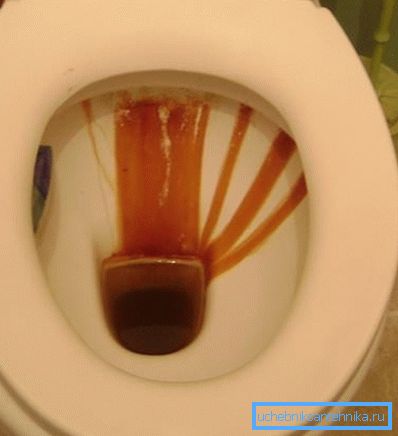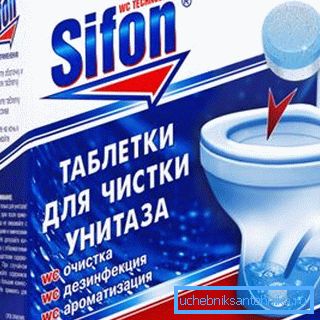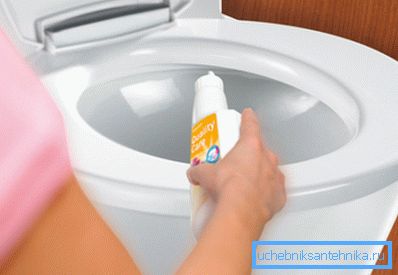Urinary stone in the toilet: how it is formed, simple and
The condition of a toilet bowl completely depends on features of its operation. Any plumbing product needs proper care. And in order not to look for the answer to the question: how to remove the urinary stone from the toilet bowl, it is necessary to properly operate this product.
Two troubles toilet bowls: lime and urinary stone does not appear in one day. These defects result from improper operation over a long period.

But if the case is already running, then you should know how to remove the urinary stone from the toilet bowl and what to do in order to prevent its occurrence in the future.
How is urinary stone formed
Rare implementation of hygienic cleaning of this sanitary product causes the formation of plaque on the drain hole and the rim. This plaque is called urinary stone. Also, the cause of its formation may be the irregular pressing of the drain button.
Often this problem occurs in families with small children. The matter is untimely and irregular flushing of urine, which leads to the fact that mineral deposits form on the walls of the drain hole. Subsequently, with an increase in its density, a urinary stone is formed. And you will not succeed in cleaning it with the help of a brush, as well as household detergents for cleaning and cleaning sanitary products.

In addition to such deposits, limescale may form under the rim. The reason for its formation is the hardness of the water and its chemical composition. To prevent the appearance of lime deposits allows regular hygienic cleaning plumbing.
Tip! To effectively combat the formation of limescale can be used tools that are designed to soften the water.
How to carry out simple cleaning
Now consider how to remove the urinary stone from the toilet, if the situation is not too running. To eliminate it, as well as to remove limescale, the same methods can be used. In that case, if we are talking about not stagnant raid, then we can get by with relatively simple cleaning measures.
The instruction assumes carrying out several stages:
- First you need to remove water from the toilet.. You can do it yourself, using a plunger or a glass with a handle.
- Now you can use any means intended for washing a toilet bowl.. They are distinguished by low price and availability. The tool must be applied to the wall, leaving at least an hour. In the event that the plaque is not removed, you can repeat this procedure several times, especially if you have chosen a liquid tool.

- Now the raid can be scrubbed with the brush.
Cardinal stone removal methods
The above method is suitable only for the removal of thin raids. But how to clean the serious deposits on the walls of the toilet? This will help you the following table.
| Pollution degree | Funds that can be used |
| Raid medium intensity. Thick compacted layer. |
|
| Chronic stale solid solid deposits. |
|
Moderate plaque removal

Now consider how to remove the urinary stone from the toilet in more detail.
With sufficiently large sediments you need to prepare the following:
- Gloves.
- Any hard brush (not metal).
- White.
- Iodine.
- Lemon acid.
- Vinegar.
- Baking soda.
In order to remove the urinary stone using these tools, there are several ways:
- We use vinegar. To do this, use 9% vinegar. Heat a glass of vinegar to 40 degrees.
Note! When heated, vinegar produces a very pungent smell, so it is advisable to cover it with a lid.
Pour baking soda into heated vinegar, then a small amount of iodine. Pour this composition into the toilet and leave it here all night so that the vinegar can dissolve.
- With the help of whiteness. To do this, remove water from the toilet. Then pour a bottle of money into it, leaving it overnight. If the result is unsatisfactory, you must rinse the plumbing fixture with warm water.

- Using citric acid. To do this, prepare a pair of sachets of acid. Put them on the toilet bowl and close the lid. Plaque dissolves within three hours. This procedure can be repeated until the product is completely cleaned.
We remove strong pollution
Here you have to prepare:
- Respirator and safety glasses.
- Rubber gloves.
- Battery Electrolyte.
- Hard brush.
- Brush.
- Oxalic acid.
Now consider how and what to dissolve deposits in the most neglected cases:
- We use technical oxalic acid. The product is sold as a dry powder. All actions must be done in rubber gloves. Apply the powder on a moistened cloth, wiping the problem areas with the surface. You can also fall asleep acid, leaving it for an hour. Rinse the product thoroughly after this procedure.

- Electrolyte use This is the most effective way to combat mineral deposits. However, this work requires compliance with all security measures: work to be in protective glasses, respirator and rubber gloves. It is necessary to pour electrolyte into the toilet, wait one hour and flush.
Tip! In the event that you have installed plastic pipes, the use of electrolyte is prohibited!
Conclusion
In this article, we looked at how to remove the urinary stone from the toilet bowl. One of the above methods will certainly allow you to get rid of deposits under the rim once and for all. Watching the video in this article, you will learn more about how to wash the toilet from urinary stone deposits.